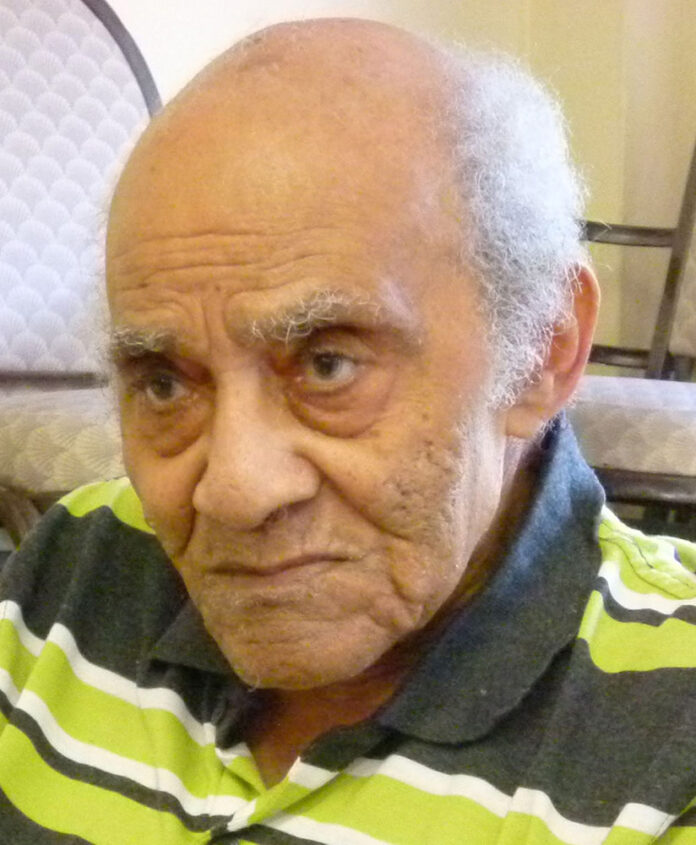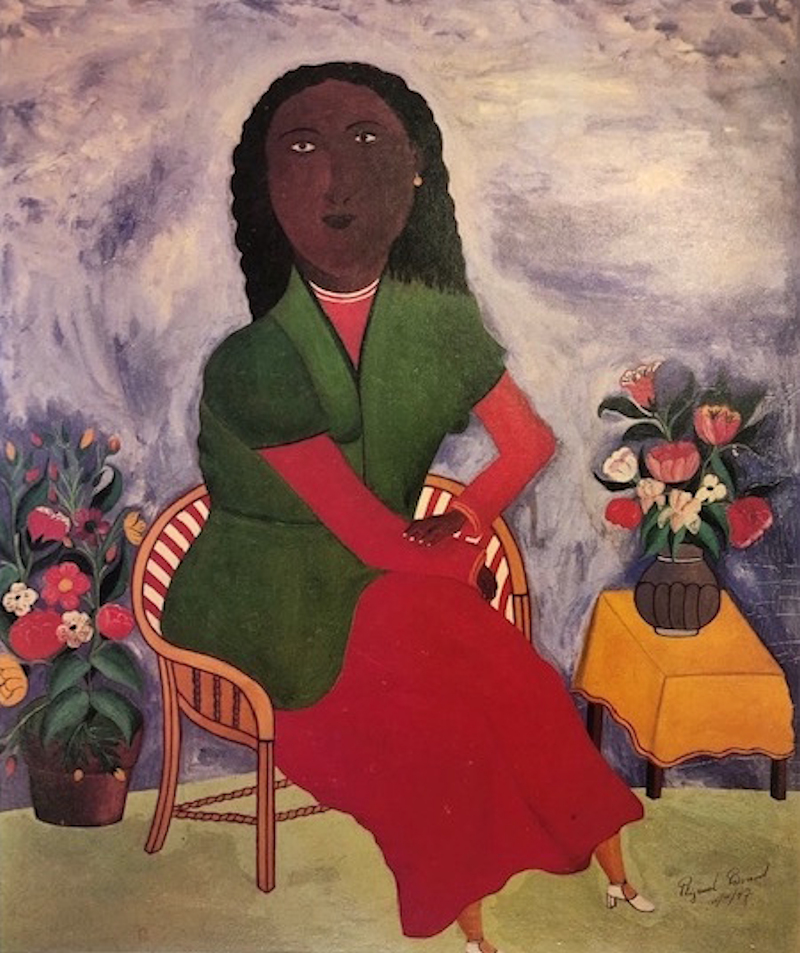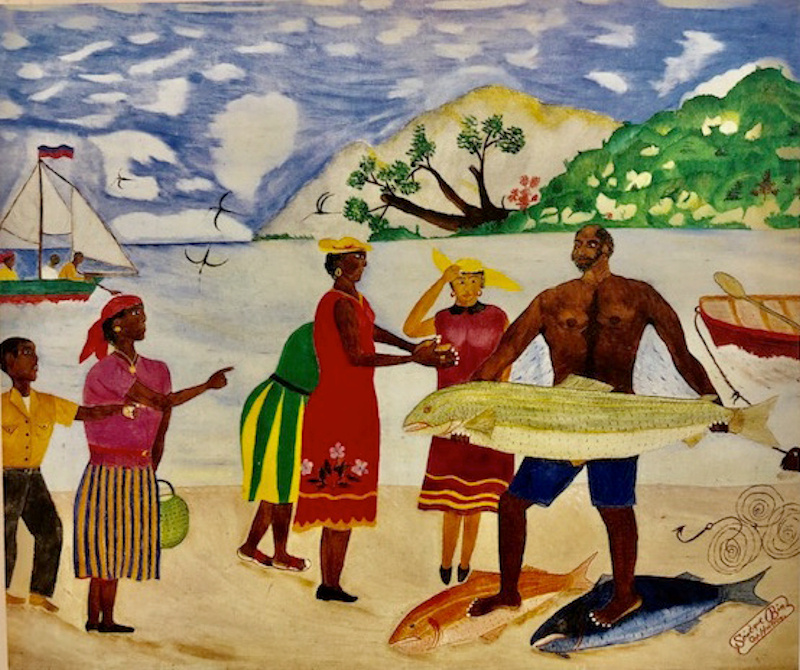
The Centre-Foyer or Primitif-Sophistiqué Dynamic
Merisier’s personal experiences during and after his Ste. Trinité period were relevant to his art, however it was the dynamic between the Centre d’Art and the Foyer des Arts Plastiques that truly situated his career. This dynamic encompassed his former as well as adopted countries since major actors from both places would continue to face off.
The writer Philippe Thoby-Marcelin, who had helped DeWitt Peters to locate Hyppolite’s home in Montrouis, published his 1958 book “Panorama de l’art haitien” principally to show that, despite the great popularity of the Primitifs, the art of the modern and Sophistiqué artists was acclaimed beyond Haiti and, particularly, in Europe. Familiar to those who have followed the Haitian art scene – not just as narrated with bias by Selden Rodman in his writings starting with Renaissance in Haiti (1948), but especially by the art historian Michel Philippe Lerebours in “Haiti et ses peintres” (1989) – the Foyer was a splinter entity that broke away in 1950 from the more well known and supported Centre d’Art, becoming a meeting and art space as well as training ground spearheaded by a few more or less trained, emerging artists egged on, reportedly, by progressive, leftist types. The stated goal of the leading Foyer Sophistiqués, among them, Lucien Price (1915-1963), Max Pinchinat (1925-1985), and the erstwhile Primitif Dieudonné Cédor (1925-2010), was generally to seek the “light” (of modern art) so as to expose members to multiple art-historical experiences across time and beyond the pressing concerns of the present moment.
a Primitif work is generally an abstraction of subject matter that’s already an abstraction.
Since Merisier’s art and the Centre-Foyer dynamic have much to do with the slippery terms “Primitif” and “Sophistiqué,” it’s worthwhile to parse their meaning. As evident in Haiti et ses peintres, “primitif” and “sophistiqué” (with lower case letters) are used to classify, respectively, the artists who were mostly self-taught and usually of working-class backgrounds and those who were generally educated, more or less bourgeois, and willing to couch their expression in established modern art idioms. Of course, both primitif and sophistiqué art could share characteristics that make them in various degrees indistinguishable. It should also be noted that the term “primitif” has been applied to different generations of artists, ranging from Hector Hyppolite (1894-1948) to Lafortune Félix (1933-2016) and the Saint Soleil painters. In contrast, “sophistiqué,” generally, denotes artists whose careers go back to mid-century Haiti and whose works are inspired by established modern art styles in ways that are (too) obvious and short-lived.
Thus, it makes little sense to apply the label to artists of such peculiar originality as Roland Dorcély – or even to Merisier, whose obviously modern art-inspired works are consistently inflected by or processed with a distinct local touch or flavor. Furthermore, the term “Primitif” (with a capital “P” and in Kreyòl, as I use it) does not necessarily translate as “primitive,” just as nèg (man) or “savoir faire” in English does not (generally) mean, respectively, “negro” or “savoir faire” in French. Haitian artists themselves, including Merisier, use the term in their art discussions and generally do not ascribe to it anything negative. Still, for those who might be rightfully sensitive to the pejorative connotation of “Primitif” (in Kreyòl or in French), one could consider referring to Haitian art that opposes, undermines, or deviates in any way from the strictures of traditional European art models as simply “Modèn” (modern). But this homogenizing impulse could also rob Haitian art history of its complexities – its own dialectics. Worse, it would make European art models too much of a touchstone for Haitian art, thus undermining its critical integrity and dynamism as well as its full development.

That Merisier saw fit to distinguish himself from his Primitif heroes as a Primitif Modèn points to not just a strain of familiar bourgeois or intellectual pride in him, pride that’s also undeniably present in the art and life of the working class Primitifs. Cédor, for instance, a dear friend of Merisier and someone who never traveled abroad, was well known for his burning desire as a Primitif to jettison his supposedly instinct-driven approach to art-making so as to embrace a more conscious, more culturally, and art-historically enlightened way of working. Merisier’s brief dalliance in 2007 with a mostly soft, brushy type of abstraction could be interpreted as an attempt to flaunt his Sophistiqué stripes. (Depas had tried his hand at abstraction starting in the late forties and, as if lured by the supposed intellectual and romantic mystique of it, Raphael Denis, who upon his arrival in New York was quite taken by Robert Delaunay’s exhibited cubist paintings at the Brooklyn Museum, would do the same late in his career.)
Merisier distinguishing his art from that of his compatriots indicates that he didn’t gauge his works’ value according to European models. As much as he emulated the art of such early 20th century expressionist masters as Soutine, Nolde, Kokoschka, Beckmann, and others, his heart was with Haitian culture, and he waged his artistic struggle for himself as well as for the Haitian nation. (At times, in art conversations, he’d throw in, “Fòk ou bay yon bagay!” (“One has to leave behind a legacy!”)) Indeed, Merisier’s self-avowed modernist distinction has little to do with the idea of progress or, specifically, with the wish to supersede Primitif art per se – an argument evinced implicitly, if not necessarily by Foyer insurgents themselves, but by Lerebours in Haiti et ses peintres, the bulwark of the Local Haitian Art Establishment. Modern and contemporary art distinctions between artists and movements have at least as much to do with theoretical issues and aesthetic style and content as with who gets to be eventually in a position to face off with society’s establishments so as, potentially, to reap the moral (or material) rewards that ensues, win or lose, from such an engagement. Ultimately, it’s much about an endeavor on the part of artists trying to parley their emotional and intellectual talents for interpreting and depicting the realities of the world into sociopolitical capital and power. And if Merisier and the Foyer artists did not articulate this thirst for power, in different ways they embodied it.
The original Primitifs themselves arguably had also long fought for power in that they prefigured Merisier’s practice of negotiating both Primitif and European (modern) art. In lots of Primitif paintings, the inconsistent space or the often disproportionate shifts in scale in the figures and objects depicted, the flattening out of forms and local colors, the sometimes untoward abutments of discreet shapes and forms that seem to merge, as if collaged together – all of this reflects (beyond, arguably, a lack of art training) a rejection of the single, consistent viewpoint or one-point perspective with which, for hundreds of years, more traditional western artists represented the world. This disregard for traditional perspective – the denial of the rational representation of spatial depth – was of course modern art’s most seminal revolution: cubism. Hyppolite transitioning, as if overnight, from tracing vèvè as a oungan and from painting, with chicken feathers, signs and floral decorations on the doors or walls of modest country dwellings to delineating more complex pictorial compositions on delimited rectangular picture planes (or the boards he worked on) entails a considerable (though not necessarily blind) leap into western art conventions. His is a conceivably harder shift than Merisier taking advantage of his art training, his well-illustrated monographs, as well as New York galleries and museums to forge his identity as a Primitif Modèn.
the differentiating factor that lends Primitif art its own identity is derived in great part from a Vodou world view and its concomitant visual culture.
But, as in the parallels between Hyppolite’s and Merisier’s leaps into modern art and their integrative approaches to art-making, the Primitif is a universal – and, thus, also modern – concept having to do with individual practitioners proposing appropriate (visual) solutions to what presents themselves as would-be original or complex visual problems. Thus, Primitif art entails an approach to art-making that’s (in cubist parlance) a mixture of both so-called “analytic” and “synthetic” approaches to the representation of what’s already conceptually or visually abstracted or schematized.
(In analytic cubism, the representation of, say, a shoe on a picture plane, or a blank surface such as paper or canvas, is of course a disjointed, fractured layout of its integral or recognizable parts, as if the shoe had been haphazardly observed in sections from multiple viewpoints. It’s basically the same for synthetic cubism – except that the various parts and sections of the depicted shoe are usually geometrically simplified or transfigured, that is, more subjectively or abstractly rendered.)
The freshness or originality to which aficionados of Primitif art say they are deeply attracted, and that Peters sought to shield from the supposed contamination of art training, has much to do with the fact that a Primitif work is generally an (immediate) abstraction of subject matter that’s already an abstraction. In other words, to Hyppolite, for instance, the would-be blank picture plane – in his case, the board on which he has to represent his subject matter or his images – is not all that blank since it presupposes or is pregnant with, so to say, the schemas in his mind, which are generated by, among myriad additional (visual) experiences, his vèvè, floral decorations, and the popular chromolithographs that were ubiquitous, especially on Vodou altars.
Likewise, to Merisier, who generally looks at inspiring exemplars of either Primitif or modern art before undertaking a painting, the blank canvas – which he often blackens, as if potentially to preload it with buried visual cues that could guide or perhaps deprogram his brush, so to say – is in a sense pregnant with either the ghosts of the Primitif or early 20th-century expressionist masterpieces he favors.
Thus, to both Merisier and Hyppolite, the picture plane consists of an a priori conceptual or visual abstraction. It’s on top of, or through, this active, ghost-like abstraction (a correlate of the would-be picture plane that potentially reflects the images already implanted in their minds) that they lay out or negotiate the actual subject matter they seek to represent. They do this by means of “analytic” expressions (their own graphically direct or indirect way of representing objects, people, animals, etc.) as well by “synthetic” expressions (their nonrepresentational or abstract passages, such as Hyppolite’s symbolic daubs of colors and stylized, decorative elements, etc.).
(Rodman uses the term “shorthand” to describe the presumed analytic approach the leading Centre d’Art Primitifs used so as to solve or sidestep the complex, visually “realistic” representation of the world – his most discreetly specific, but still imprecise, contribution to Haitian art theory.)
Of course in various degrees, this duo-pronged process or, analogously, the morphing of the artist as subject and the realities that he or she seeks to represent – the object, that is – applies to all creators. But with trained artists in the western tradition, there’s a more direct correspondence or visual similarity between that which has to be represented (usually by observation of objective reality or, partly, by memory) and the schemas (or picture planes) that prefigure the subject matters (or things) to be depicted. In other words, in the western art tradition, the more one is technically trained in or accustomed to depicting and mimicking what the external world objectively looks like, the more the object or external reality prefigures, dominates, and even molds the artist as subject or as intentionality.
In contrast, in the Primitif approach, the artist as subject is the active agent that determines or, even, deconstructs, so to say, the object, that which has to be represented. (Of course, it’s also true that pecuniary incentives and the potential social capital to be gained by being able to depict convincingly a given subject matter for a patron or a community do in fact filter into and somehow influences the artist as subject.)
But aside from such incentives to depict a given subject matter on the spot, or as if with very little or almost no prior training or experience (since the subject matter and/or the format in which it’s to be depicted seems inordinately new or complex), the major differentiating factor that lends Primitif art its own identity and distinguishing qualities is its practitioners’ bank of a priori mental as well as objective local images, derived in great part from a Vodou world view and its concomitant visual culture. (Since Vodou usually adapts itself to any structure, this applies as well to Philomé Obin, an artist of protestant faith.)
Since the distinction between objectivity and subjectivity – or between high and low art – is usually non-existent in Vodou, the Primitif approach is as much in sync with this belief-system as it is with the workings of local crafts. Thus, Primitif art, from any generation (much like the earliest insurrections propelled by mostly kidnapped West Africans as if without entrenched leadership or a standard play book, so to say, and that nevertheless in great part led to Haiti’s independence in 1804) has much to do with the can-do attitude of creators, both as individuals and as embodiments of an uncodified and embryonic social or collective mind. To a great extent this explains why Primitif art often seems to exist as if unchanged by history.

The Foyer insurgents’ and Merisier’s stated need to distinguish themselves from the practice of the Primitif artists has more to do with an unstated wish to transmute mere art talent and energy – as, for instance, in Cédor’s case – into a more lasting form of power that could be (socio-economically) instrumentalized at will. Conceivably, it’s a wish for power that supersedes, analogously, the ostensibly improvised maneuvers of the (early) rank and file insurrectionists of the Haitian revolution so as to end up with, say, the more codified precepts in Jean-Jacques Dessalines’ 1805 constitution.
It’s only when the theory and history of Haitian modern art is locally determined and more or less instrumentalized that the urgent interpretation of some of the key terms that characterize the movement (Primitif, Sophistiqué, and even Modèn as well as Primitif Modèn) will start to serve the needs of the community that produces such art. If, as seen, Primitif and Sophistiqué, or Hyppolite and Merisier, theoretically have much in common, it’s also true that the Sophistiqués had other motives for breaking away from the Centre. Theirs was also a wish to sell more of their art relative to the often less expensive and thus more salable fantastical Primitif fare favored by mostly tourist buyers. Having experienced the workings of the Haitian art market within and even beyond the purview of the Centre, there was naturally no longer a need for the Sophistiqués to function – as if without their own sense of independence and power – in the structures laid out by a foreign-dominated entity.
Peters would steer the Centre in the camp of the Primitifs about two years after its founding.
Moreover, one is to believe that, according to Lerebours, the Foyer’s leading lights wanted to take into account the lessons of the Primitifs with the stated purpose and vision of surpassing them – primarily by incorporating in their work the “most advanced techniques” of modern art. This is a complete fallacy that Haiti et ses peintres seems to compound since modernism – which prizes originality and oppositionality above all – has little to do with the emulation of “advanced techniques”. (Except for their brief September 1950 manifesto, original documents from the early fifties that actually spell out and elaborate the original Sophistiqués’ mission are pretty sparse.) But Merisier discounted such earnest goals, opting to underscore a dearth of open artistic exchanges between the sequestered Primitifs on the lower level of the Centre and the Sophistiqué (or more bourgeois) artists on its upper floor, a practice paternalistically encouraged by Peters so as ostensibly to safeguard the Primitifs’ originality.
But there were plenty of exchanges between Sophistiqués and Primitifs at the Foyer and, as Lerebours relates it, there was at first, for about two years, some degree of collaborative art training at the Centre. It’s also true that beyond the walls of the Foyer and, especially, the Centre, there wasn’t much socializing among the artists of the two camps in Port-au-Prince’s class-stratified society. This was unfortunate because, beyond the acquisition of the fundamentals of one’s craft or of even “advanced techniques” (which of course is elementary and does not at all automatically make one an artist), more advanced or pertinent art training generally issues from the perceived singularity of one’s social interactions and aesthetic leanings relative to what one considers to be the actual or imagined circumstances of one’s life. In other words, it’s mostly about the conscious or unconscious integration of one’s aesthetic attitude or disposition vis-à-vis one’s social world. A former student of Fernand Léger in Paris and a figurative painter whose comfortably competent works bear some of the loose touches and urbane qualities of the modernist Raoul Dufy, Peters would steer the Centre in the camp of the Primitifs about two years after its founding. But this shift occurred not without some strong nudges from, among others, Rodman and, especially, from the visiting Cuban critic Jose Gomez Sicre.
(To be continued)









